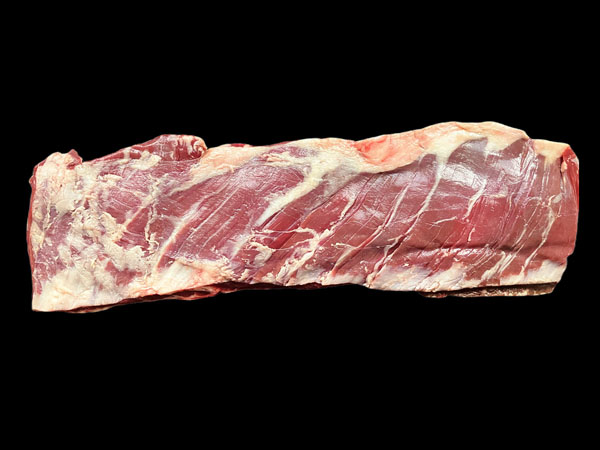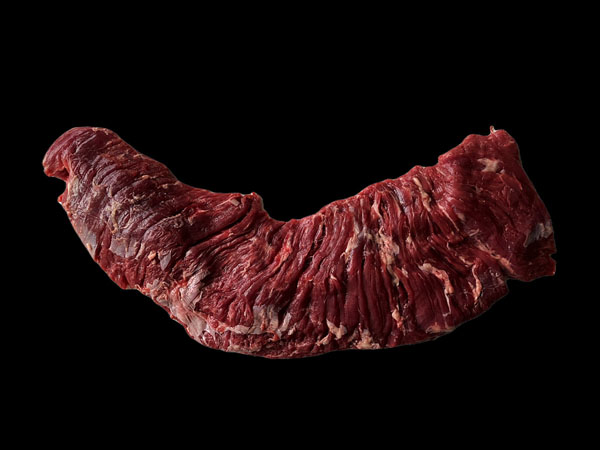Hanger steak is a lesser-known cut with exceptional flavor and juiciness. When cooked right, it’s truly delicious. In this guide, I’ll show you where it comes from on the cow, what makes it special, how to trim it properly, and the best ways to cook it.
What is Hanger Steak?
The hanger steak is a lesser-known cut from the cow’s plate primal. It gets its name because it hangs from the cow’s diaphragm. Hanger steak is a lean cut of beef with a robust flavor, decent tenderness, and plenty of juiciness. The best way to enjoy it is to sear it quickly on a hot grill or pan, then slice it against the grain, just like you would with flank or skirt steak.
Even though its price has gone up over the years, hanger steak is still a fantastic, budget-friendly alternative to more expensive cuts like ribeye or strip steak, making it a great choice for a delicious steak dinner.
At first glance, a hanger steak might not look like a typical cut, but with the right prep, it comes into its own. By trimming off excess fat and removing the central sinew, the steak transforms into two ready-to-cook long cuts, with one being slightly thicker. For more even cooking, I like to cut them into two or three smaller pieces so they have a consistent thickness. Below are photos of the trimmed, raw hanger steak.



What Are the Other Names for Hanger Steak?
Here are some of the most popular other names for the hanger steak in the United States:
- Hanging Tender Steak,
- Hanging Tenderloin Steak,
- Butcher’s Steak,
- Butcher’s Cut,
- Bistro Steak.
Historically, the names “Butcher’s Steak” and “Butcher’s Cut” come from a time when butchers reserved this cut for themselves because of its exceptional flavor and tenderness.
Where Does the Hanger Steak Come From on a Cow?
Hanger steak comes from the plate primal, just below the tenderloin on the left side of the cow. There’s only one hanger steak per cow, which makes it a rare cut.

Hanger Steak Nutrition
| Nutrition | Portion size: 4 oz = 113 g |
|---|---|
| Calories | 152 |
| Total Fat | 6.25 g |
| Carbs | 0 g |
| Sodium | 58 mg |
| Protein | 23.2 g |
Data source: USDA.
What Does Hanger Steak Taste Like?
Hanger steak has a seriously beefy flavor – one of the most intense you’ll ever taste. It’s also incredibly juicy, which is a huge plus. All you really need is a good pinch of salt and pepper and a quick, hot sear to medium-rare to bring out its full flavor. Sure, you can marinate it if you like since its loose texture absorbs flavors well, but honestly, if you’ve got a good piece, it doesn’t need much else.

How Tender Is the Hanger Steak Compared to Other Cuts?
Hanger steak is naturally tender with a satisfying chew. When cooked to medium rare or medium and sliced against the grain, it can be as tender as some high-end cuts (like new york strip or flank steak). However, it becomes noticeably tougher if sliced with the grain (like skirt, flank, or flap steak).
What is The Average Weight of The Hanger Steak?
A whole hanger steak typically weighs between 1.5 and 3 pounds (about 0.68 to 1.36 kg) before trimming. Most butchers trim it into two long pieces of roughly 1 pound (450 grams) each, though some may slice it further into 8-12-ounce (227-340 grams) steaks that are easier to cook in a pan.



Sometimes, you might find a butterflied hanger steak, which is much thinner. If you’re expecting a nice, regular steak, it’s best to avoid those. I recommend choosing thicker hanger steaks since they’re much easier to cook to perfection.
I once bought a hanger steak that was only 0.5 inches (1.3 cm) thick – a lesson learned. Realizing it wasn’t ideal for a traditional steak, I did my best to cook it and then sliced it thinly for a salad. Here’s how that turned out.



What is The Average Length of a Hanger Steak?
On average, a hanger steak measures about 13 inches (33 cm) in length, making it one of the longer cuts of steak.

Why is Hanger Steak Expensive?
Not too long ago, hanger steak was one of the cheaper cuts of beef. But as more people discovered its amazing flavor, juiceness, and tenderness, demand skyrocketed, and the price jumped. But the main reason behind the price jump is its limited availability – each cow only has one hanger steak, weighing just between 1.5 and 3 pounds (roughly 0.68 to 1.36 kg) before trimming. Limited availability is the biggest reason you’re paying more for hanger steak nowadays.
What Are the Best Methods for Cooking Hanger Steak?
Here are the best cooking methods for hanger steak:
- Pan-Searing Only: I enjoy pan-searing hanger steak because it’s quick and effective. It takes some practice to avoid overcooking, but it’s perfect for dry-marinated, thicker cuts. Cooking it fast over high heat creates a gorgeous crust while keeping the inside perfectly medium-rare – this method is one of my favorites for preparing this cut inside.
- Grilling: Grilling is another fantastic method to cook hanger steak, and, in my experience, it is easier than traditional pan searing. Start by cooking the hanger steak over direct heat to build a great crust, then move it to indirect heat to finish cooking slowly at a lower temperature – this method helps prevent overcooking while adding a lovely smoky flavor to the steak. Plus, it’s also the best way to cook wet-marinated steaks.
- Sous Vide: Sous vide is the most foolproof method for cooking thicker steaks like hanger steak. It lets you cook the hanger steak to your perfect doneness every time. Once done, pat the steak dry and sear it for 30 to 45 seconds per side over very high heat (on a grill or in a pan) to form a tasty crust. It takes a bit more time and requires a sous vide machine, but the consistently amazing results make it perfect for anyone who worries about overcooking.
- Pan Searing and Oven Finishing: Combining pan searing with finishing the steak in the oven is a fantastic way to get the best of both methods. Start by searing your hanger steak in a hot pan to form a delicious crust, then transfer it to the oven at a lower temperature to finish cooking it gently. This method is a great way to avoid overcooking – it works especially well for thicker steaks, ideally at least 1.5 inches (3.8 cm) thick.
- Reverse Searing: The reverse searing technique combines slow, gentle cooking with a quick, high-heat sear. Start by cooking your hanger steak slowly at a low temperature so it cooks evenly. Just before it reaches your desired doneness, take it off the heat and let it rest for a bit. Then, sear it for 30 to 45 seconds per side over high heat to form a great crust. This method helps you achieve perfect doneness without overcooking. You can begin the slow cooking in the oven or grill, then finish it with a quick sear in a hot pan or over any open flame.
To bring out the best in hanger steak, cook it at high heat to create a flavorful crust without overcooking the inside. Just be sure to use an instant-read thermometer to check that the steak doesn’t go past medium-rare doneness, which is the ideal doneness for this cut. Don’t forget to slice hanger steak against the grain when it’s time to serve. This simple step shortens the muscle fibers, making the meat noticeably more tender and easier to chew.
With these techniques, you’ll enjoy a hanger steak rich in flavor and very tender with every bite.








